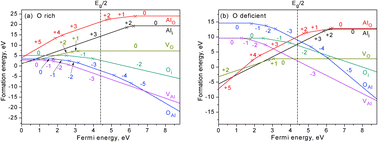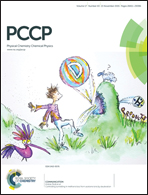A new perspective on the process of intrinsic point defects in α-Al2O3
Abstract
First-principles plane-wave pseudopotential calculations have been performed to study the charge states and energetics of intrinsic point defects as vacancies, interstitials and antisite atoms in α-Al2O3, and thus a new perspective on the process of intrinsic point defects has been proposed. Considering the various charge states for each intrinsic point defects, VAl3−, V0O, Ali3+, Oi2−, AlO3+, and OAl3−, not all in their fully ionized states are found to be most stable and in pure Al2O3. From the formation energies of individual point defects, the antisite atom OAl will be readily formed in α-Al2O3 in an O-rich environment. By combination of charge states and formation energies, the defect types of Schottky, Al Frenkel and antisite pairs formed are found to be dependent on the O condition, and the most stable Schottky defect type is not the commonly considered {3VO2+:2VAl3−}. There are two types of possible O Frenkel defects under both O conditions, yet the most stable defect is {Oi1+:VO1−} rather than the commonly believed {Oi2+:VO2−}. The bizarre configuration and the charge state of Schottky and Frenkel defects predicated in this work provide a new perspective on the process of intrinsic point defects in α-Al2O3.


 Please wait while we load your content...
Please wait while we load your content...